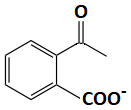
| 1. |  |
| 2. |  |
| 3. |  |
| 4. |  |
Prefer Books for Question Practice? Get NEETprep's Unique MCQ Books with Online Audio/Video/Text Solutions via Telegram Bot
NEET MCQ Books for XIth & XIIth Physics, Chemistry & Biology
| 1. |  |
| 2. |  |
| 3. |  |
| 4. |  |
Prefer Books for Question Practice? Get NEETprep's Unique MCQ Books with Online Audio/Video/Text Solutions via Telegram Bot
NEET MCQ Books for XIth & XIIth Physics, Chemistry & Biology
| 1. |  |
2. |  |
| 3. |  |
4. |  |
Prefer Books for Question Practice? Get NEETprep's Unique MCQ Books with Online Audio/Video/Text Solutions via Telegram Bot
NEET MCQ Books for XIth & XIIth Physics, Chemistry & Biology\(\mathrm{CH}_3 \mathrm{COCH}_3 \stackrel{\mathrm{dil.~Ba}\left(\mathrm{OH)}_2\right.}{\longrightarrow} \text { " } \mathrm{X} "\)
The functional groups present in the compound "X" are:
1. Ketone and double bond
2. Double bond and aldehyde
3. Alcohol and aldehyde
4. Alcohol and ketone
Prefer Books for Question Practice? Get NEETprep's Unique MCQ Books with Online Audio/Video/Text Solutions via Telegram Bot
NEET MCQ Books for XIth & XIIth Physics, Chemistry & Biology
1. Stephen reaction
2. Gattermann-Koch reaction
3. Etard reaction
4. Rosenmund reaction
Prefer Books for Question Practice? Get NEETprep's Unique MCQ Books with Online Audio/Video/Text Solutions via Telegram Bot
NEET MCQ Books for XIth & XIIth Physics, Chemistry & Biology
| 1. |  |
2. |  |
| 3. |  |
4. |  |
Prefer Books for Question Practice? Get NEETprep's Unique MCQ Books with Online Audio/Video/Text Solutions via Telegram Bot
NEET MCQ Books for XIth & XIIth Physics, Chemistry & Biology| List-I (Products formed) |
List - II (Reaction of carbonyl compound with) |
||
| (A) | Cyanohydrin | (I) | NH₂OH |
| (B) | Acetal | (II) | RNH₂ |
| (C) | Schiff's base | (III) | Alcohol |
| (D) | Oxime | (IV) | HCN |
| (A) | (B) | (C) | (D) | |
| 1. | (IV) | (III) | (II) | (I) |
| 2. | (III) | (IV) | (II) | (I) |
| 3. | (II) | (III) | (IV) | (I) |
| 4. | (I) | (III) | (II) | (IV) |
Prefer Books for Question Practice? Get NEETprep's Unique MCQ Books with Online Audio/Video/Text Solutions via Telegram Bot
NEET MCQ Books for XIth & XIIth Physics, Chemistry & Biology| 1. |  |
| 2. |  |
| 3. |  |
| 4. |  |
Prefer Books for Question Practice? Get NEETprep's Unique MCQ Books with Online Audio/Video/Text Solutions via Telegram Bot
NEET MCQ Books for XIth & XIIth Physics, Chemistry & BiologyGiven below are two statements:
| Statement I: | Aldehydes and ketones having at least one \(\alpha\)-hydrogen undergo aldol condensation in the presence of dilute alkali as catalyst. |
| Statement II: | When aldol condensation is carried out between two different aldehydes, it is called cross aldol condensation. Ketones do not give this reaction. |
In light of the above statements, choose the most appropriate answer from the options given below:
| 1. | Statement I is correct and Statement II is incorrect. |
| 2. | Statement I is incorrect and Statement II is correct. |
| 3. | Both Statement I and Statement II are correct. |
| 4. | Both Statement I and Statement II are incorrect. |
Prefer Books for Question Practice? Get NEETprep's Unique MCQ Books with Online Audio/Video/Text Solutions via Telegram Bot
NEET MCQ Books for XIth & XIIth Physics, Chemistry & Biology
| 1. |  |
2. |  |
| 3. |  |
4. |  |
Prefer Books for Question Practice? Get NEETprep's Unique MCQ Books with Online Audio/Video/Text Solutions via Telegram Bot
NEET MCQ Books for XIth & XIIth Physics, Chemistry & Biology